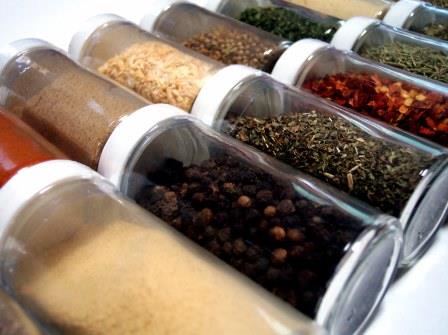My brother is actually quite interested in cooking and loves to experiment when he has time but as we sat down to eat, he just looked at me in amazement and said “that’s what I want to be able to do – be able to throw a meal together without thinking and without a recipe, quickly. How the heck did you know what went with what?”
We got to talking and he actually suggested the topic for this blog (my whole family avidly reads it.) He suggested just a simple list of different herbs, spices, and cupboard staples that he could reference when trying to cook. Of course as a science teacher, he requested a Venn diagram of spices that would show all possible relations and combinations – perhaps a bigger project…

Last week I was home in Chicago to attend the National Restaurant Show and visit four of our Great Harvest bakeries in the area. I had the rare pleasure of being on a business trip and returning most evenings to my parent’s house for dinner. One night after I threw together some Asian inspired sautéed green beans he reminded me of his blog request. A couple of nights later, I grilled a whole yellowtail snapper inspired by North African flavors: I stuffed the cavity with whole sprigs of oregano, cloves of garlic, and lemon slices and rubbed the whole thing down with a mixture of paprika, cayenne, turmeric, ginger, cumin, coriander, garlic powder, kosher salt, and black pepper.

With so many ingredients and possible combinations this is clearly bigger than just one blog post – but today I will attempt to address a few.
I started thinking about how I cook and how people actually learn how to cook. Of course I was in culinary school fourteen years ago at the Culinary Institute of America but I do really remember the freedom that came when I stopped thinking in terms of recipes and started thinking in terms of flavor combinations. That is how the best cooks and chefs really function – I don’t have to think real hard about what I am putting in a particular dish I am making, it is more about a general theme.
Do I want tonight’s vegetables to have a sparkly bright Latin feel to them? I reach for cumin, coriander, chili flakes, lime juice, and cilantro. For the Asian green beans the natural accompaniments were shiitakes, ginger, garlic, scallions, sesame oil, lemon, and a touch of soy. I added some toasted macadamia nuts at the end for a little crunch (I would have added some chopped cilantro but in our family - like in many - that is a polarizing ingredient).
So here is my first attempt at providing a blueprint for culinary success in the kitchen based on flavor combinations. We will continue this in future blog posts but here are the first three tips. This is by no means an exhaustive list, merely some great suggestions. You will notice that there is ingredient crossover between themes - sorry no Venn Diagram included…
1. Latin American/Mexican
Cumin, coriander, paprika, chipotle powder/puree, jalapeños or countless other hot peppers, lime juice, orange juice, cilantro, garlic, oregano, mint, sesame seeds, cinnamon, onions, scallions, chocolate, tomato, peanuts
2. Southeast Asian
Ginger, garlic, scallions, hot peppers, sesame oil, sesame seeds, miso paste, soy sauce, fish sauce, limes, cilantro, basil, mint, coconut, coconut milk, oranges, peanuts, cinnamon, coriander, rice wine vinegar, mustard seeds
3. Southern Mediterranean /North African
Garlic, cumin, coriander, tomatoes, paprika, cinnamon, ginger, turmeric, mustard, olives, olive oil, ginger, cilantro, lemons, hot peppers, harissa paste, parsley, peanuts, mint, almonds, basil, cloves, oregano, dried apricots
As I always try to explain to people, the real idea here is to combine a few ingredients in each dish that represent different categories: an oil, something acidic, a fresh herb, something crunchy, a dried spice or too, etc. See the dishes I described above for examples.
Have fun experimenting and let me know what some of your favorite flavor combinations are in the comments section below!
Check out some of the recipes Scott has developed here:




